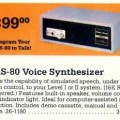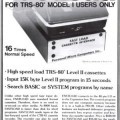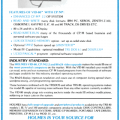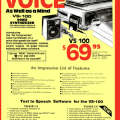The Radio Shack Double-Density Disk Kit
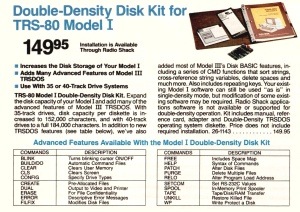
Radio Shack Double-Density Disk Kit from a 1982 Radio Shack catalog
The original TRS-80 Model I, when paired with a Radio Shack Expansion Interface, was only capable of single-density floppy disk access. This limitation was addressed by the Percom Doubler, introduced in 1980, which modified the Expansion Interface to add double-density. The Percom Doubler soon became the de-facto standard for double-density interfaces on the Model I. Almost all companies that created double-density add-ons made them compatible with the Percom Doubler.
The Radio Shack Double-Density Disk Kit (catalog number 26-1143) was Radio Shack’s own double-density add-on for the Model I. Introduced on May 1, 1982 (nearly one and a half years after the Model I was discontinued), the Double-Density Disk Kit cost $149.95, not including installation. Despite the official name, most people referred to it as the Radio Shack Doubler.
Like the Percom Doubler, the Double-Density Disk Kit installed inside the Radio Shack Expansion Interface. It was described this way in the catalog:
Expand the disk capacity of your Model I and add the advanced features of Model III’s TRSDOS operating system. After Radio Shack has installed the kit in your Expansion Interface, your existing Model I software may still be used “as is” in single density mode. With the all new Double-Density Disk Operating System, use advanced features and gain increased disk capacity with your current disk drives.
Radio Shack chose to create a new interface to the double-density controller for the Double-Density Disk Kit rather than follow the standard established by Percom. Although data transfers were performed similarly, switching between single- and double-density was done in a completely different manner. That made the Double-Density Disk Kit incompatible with all existing Model I double-density operating systems.
Radio Shack included TRSDOS 2.7, a brand new operating system, with the Double-Density Disk Kit. TRSDOS 2.7 (later upgraded to TRSDOS 2.8) was not a new version of TRSDOS 2.3. It had more in common with Model III TRSDOS, partly because both had roots in Model II TRSDOS.
Despite the similarities to Model III TRSDOS, TRSDOS 2.7 couldn’t read Model III TRSDOS disks or run Model III TRSDOS programs. It could read most Model I disks and run most Model I programs, but there were still many compatibility problems. Radio Shack referenced those problems in the catalog:
Since our Double-Density TRSDOS contains many new features, modifications of some existing software may be required for use with double-density. Even though most BASIC programs and many machine-language programs will run “as is” in Double-Density TRSDOS, Radio Shack applications software is not available or supported for double density operation.
The statement that Radio Shack would not support their own programs on TRSDOS 2.7 wasn’t exactly a vote of confidence in the operating system. In their next catalog, Radio Shack also offered a version of LDOS which supported the Double-Density Disk Kit.
Soon new versions of NEWDOS/80, DOSPLUS, and MULTIDOS were released which also supported the Double-Density Disk Kit. That meant all of the major Model I operating systems would work with either the Percom Doubler or the Radio Shack Double-Density Disk Kit. Ordinary application software would work identically on either doubler, with the operating system masking any differences.
The Radio Shack Double-Density Disk Kit remained in the Radio Shack catalog until 1984.
